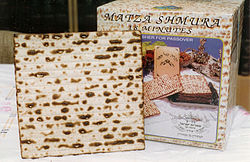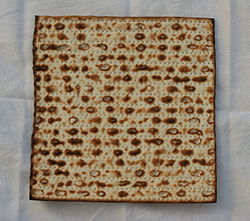
Back Matso Afrikaans مصة Arabic مصه ARZ Matze BAR Маца Byelorussian Маца Bulgarian Matzah Breton Matsà Catalan Maces Czech Matze German
 Machine-made matzot from Jerusalem | |
| Alternative names | Matzo, matza |
|---|---|
| Type | Flatbread |



Matzah, matzo, or maẓẓah[1] (Hebrew: מַצָּה, romanized: maṣṣā, pl.: matzot or Ashk. matzos) is an unleavened flatbread that is part of Jewish cuisine and forms an integral element of the Passover festival, during which chametz (leaven and five grains that, per Jewish law, are self-leavening) is forbidden.[2]
As the Torah recounts, God commanded the Israelites[3] (modernly, Jews and Samaritans) to eat only unleavened bread during the seven-day Passover festival. Matzah can be either soft like a pita[4] or crispy. The crispy variety is widely produced commercially because of its long shelf life. The soft matzah needs to be frozen if it is to last more than a day or so, and very limited commercial production is available, and only in the period leading up to Passover. Some versions of the crisper type are available all year.
Matzah meal and matzah cake meal is crispy matzah that has been ground very finely. The cake meal has a near flour-like consistency, useful in baking, while the standard matzah meal is somewhat coarser and used in cooking. Matzah meal is used to make matzah balls (kneidles/kneidlach), the principal ingredient of matzah ball soup (kneidlach soup). Sephardic Jews typically cook with matzah itself rather than matzah meal.[2]
Matzah that is kosher for Passover is limited in Ashkenazi tradition to plain matzah made from flour and water. The flour may be whole grain or refined grain, but must be made from one of five grains: wheat, spelt, barley, rye, or oat. Some Sephardic communities allow matzah to be made with eggs and/or fruit juice to be used throughout the holiday, while Ashkenazi Jews do not use such matzah on Passover, except in special circumstances (generally, the sick and elderly).[5]
- ^ Trachtenberg, Joshua (13 February 2004) [Originally published 1939]. "Glossary of Hebrew Terms". Jewish Magic and Superstition. Philadelphia: University of Pennsylvania Press (published 2004). p. 333. ISBN 9780812218626. Retrieved Feb 6, 2023.
Maẓẓah—unleavened bread.
- ^ a b "Eating Matza - Jewish Tradition". yahadut.org. Retrieved 2024-04-04.
- ^ Exodus 12:15
- ^ Cite error: The named reference
intimewas invoked but never defined (see the help page). - ^ Posner, Menachem. "Is Egg Matzah Kosher For Passover?". Chabad.org. Lubavitch World Headquarters. Retrieved 3 April 2018.